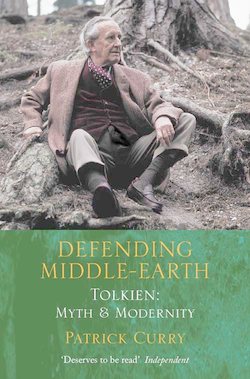Читать книгу Defending Middle-earth: Tolkien: Myth and Modernity - Patrick Curry - Страница 6
The Story
ОглавлениеThis book will undoubtedly make more sense if you have already read The Lord of the Rings; but if you have not, or need reminding, here is a very brief synopsis. It takes place in the Third Age of Middle-earth – our Earth, but in an imaginary period a very long time ago. Frodo Baggins of the Shire, where the hobbits live, inherits a magic ring from his uncle Bilbo, who had acquired it from a fallen hobbit, Gollum, in the course of adventures recounted in The Hobbit. Gandalf the Grey, a wizard, realizes that it is the One Ring, eagerly sought by its maker Sauron, the ruler of Mordor and the greatest power in Middle-earth. With the Ring, Sauron would be invincible. The only hope is to try to smuggle the Ring into Mordor and cast it into the furnace of Mount Doom where it was forged; for it cannot be destroyed in any other way, and anyone who tries to use it against Sauron would simply become another Dark Lord.
Frodo and his devoted companion Sam therefore begin the quest to return the Ring to its source. Initially, they are accompanied by the Company, including and representing the ‘free peoples’ of Men, Elves and Dwarves, as well as Gandalf and two other hobbits, Pippin and Merry. But the Company is soon dispersed, and from then on (most of the book), the reader follows two parallel stories: the adventures of its remaining members in the War of the Ring, as they struggle to keep Sauron occupied and distracted, and the agonizing journey of Frodo and Sam, accompanied by the treacherous Gollum.
Although Gandalf has always been its chief strategist, the war against Sauron is increasingly led by Aragorn, the hitherto unknown heir to the thrones of Arnor (now vanished) and Gondor (still the chief kingdom of resistance among Men). In its course, followed principally through the fortunes of Merry and Pippin, we meet some extraordinary places and people, both human and otherwise – including Lothlórien, the last remaining stronghold of pure Elvish ‘magic,’ where the powerful elven lady Galadriel lives; the fierce feudal Riders of Rohan; the Ents, sentient, talking and moving trees; Shelob, a malevolent spider-being; the nine Ringwraiths, Sauron’s lieutenants; and Saruman, a corrupted wizard.
When Frodo does arrive, he is mastered at the last moment by the Ring, and claims it; but Gollum bites it off his finger, loses his balance, and falls into the Crack of Doom holding it. The works of Sauron come to a cataclysmic end, and Frodo and Sam are just saved from the wreck. Eventually, after Aragorn’s coronation and wedding, and together with Pippin and Merry, they return to the Shire to find their struggles not yet over. But order is finally restored, and after a few years Frodo (who never really recovers from his ordeals) is allowed to pass over the Sea to within sight of Elvenhome, together with some of the last and greatest Elves and Gandalf. Sam remains in the Shire with his wife and family.
The Lord of the Rings is not really a trilogy, that being merely the publisher’s device for breaking it up into manageable-sized volumes; it is written in six ‘books,’ largely following the two parallel stories. Middle-earth’s languages (both written and spoken), the histories of its various peoples, calendrical systems, and some family trees are discussed in detailed appendices – all too briefly for those readers who have fallen in love with the book en route. (Those who haven’t won’t have gotten that far.)
